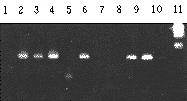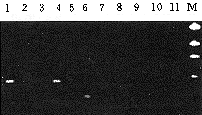宫颈癌组织P16基因突变分析
临床检验杂志 1999年第3期第0卷 临床化学
作者:梁业丽 冯英邦 王建勋
单位:梁业丽 冯英邦(高州市妇幼保健院,广东高州525200);王建勋(广东医学院附属医院)
关键词:宫颈癌;重复顺序;P16基因突变;聚合酶链反应
摘要 探讨P16基因突变在宫颈癌发生中的作用及基因突变的机制。利用点突变检测仪、水平和垂直板电泳对P16基因的外显子1、外显子2的PCR扩增产物作缺失和点突变分析。结果在29例临床宫颈癌标本中有8例发生缺失突变,4例发生点突变,突变率约41%。其中1例外显子1为不完全缺失突变即有低于343 bp的扩增带。P16基因的发生突变原因是因为其含有“CG”DNA重复顺序,易发生DNA重组及易位和重排。
Mutation analysis of P16 gene in cervical carcinoma
LIANG Yeli,FEN Yinbang,WANG Jianxun
(Hosptial of Gaozhou Women and Children,Gaozhou 525200)
Abstract To analyze the role of P16 gene mutation in cervical carcinoma genesis and mechanism of P16 gene mutation.The exon 2 and exon l of P16 gene was amplified by polymerase chain reaction respectivly.The products were analyzed by CDGE(constant denatured gel electrophoresis in DcodeTM apparatus)and 1.8 g/dl agarose get seperately.There are total 8 deletion mutational cases and 4 point mutations from 29 clinical specimens.The mutation rate is about 41%,and 1 of 4 exon 1 deletion mutations is uncomplete deletion mutation,which has an amplified DNA band less 343 bp.Mutation of P16 gene has played an important role in cervical carcinoma genesis.becaucse its exons own“CG”DNA repetitive sequence,P16 gene is apt to lose part of the sequence leading to mutation,so the mechanism of the mutation is that recombination and rearragement of the “CG”repetitive sequence lead to uncomplete DNA deletion.It is the reason that the rate of deletion mutation is higher than that of point mutation.
Key words cervical carcinoma; polymerase chain reaction; repetitive sequence; P16 gene mutation analysis
目前,在9P21区内发现一种新的抑癌基因即P16/CDKN2/MTSI基因[1,2]。P16/CDKN2/INK4基因是一个与细胞周期相关的基因,其编码的蛋白质可与CDK4(细胞周期蛋白依赖性激酶4)和CDK6结合,对细胞分裂起控制作用,一般认为P16是直接控制细胞分裂的基因[3]。P16基因的突变将会导致细胞无控制的生长和癌症的产生。已有报道认为在多种恶性肿瘤的组织中P16基因发生多种遗传变异。本文报道用宫颈癌组织标本对P16基因外显子1、外显子2进行缺失突变和点突变分析研究,发现宫颈癌细胞P16基因缺失突变率为28%,点突变率为14%。缺失突变的原因可能是基因外显子具有丰富“CG”DNA重复顺序。
1 材料和方法
1.1 标本 宫颈癌组织标本来自本院妇产科共29例,均经组化分析确诊。
1.2 主要试剂和仪器 Tag酶、饱和酚、琼脂糖、丙烯酰胺、甲叉双丙烯酰胺、四甲烯二胺、过硫酸铵、尿素等购自GIBCOBRL公司;蛋白酶K、SDS购自Sigma公司;点突变检测仪、水平和垂直板电泳槽、电泳仪、成像系统(Image System Gel DC1000)购自Bio-Rad公司;高速低温离心机购自Beckman公司;PCR扩增仪购自Thermolyne公司。
1.3 DNA的抽提 用传统的酚-氯仿抽提法[8]。
1.4 PCR扩增加缺失分析 PCR扩增引物按文献设计[1,4],由北京赛百盛公司合成;外显子1(343 bp),P1为5′-GAAAGGAGAGGAGGGGCT-3′,P2为5′-GCGCTACCTGATTCCAATTC-3′和外显子2(509 bp)P3为5′-GGAAATTGGAAACTGGAA
GC-3′和P4为5′-TCTGAGCTTTGGAAGCTCT-3′。扩增条件:1 μmol/L引物,200 μmol/L dNTPs,2 U Tap聚合酶,200 ng DNA模板,3 μl 10×PCR扩增缓冲液(10×TAE),反应体积为30 μl,在94℃ 45 s,51℃ 45 s,72℃ 50 s条件下共35个循环。PCR产物在18 g/L琼脂糖凝胶电泳90 min,溴化乙锭染色20 min,在成像系统中摄影。
1.5 点突变分析 利用Bio-Rad公司生产的单碱基突变检测系统(DcodeTM)对PCR扩增产物作均一变性凝胶电泳(CDGE,constant denatured gel electrophoresis)分析。即在100 g/L PAGE(聚丙烯酰胺凝胶电泳)中加入尿素,使其到达51%的变性度。电泳缓冲液为1×TAE,在56℃条件,用130 V,电泳3 h。然后溴化乙锭染液浸泡20 min,取凝胶置于成像系统(Image System DC 1000)中摄影。在DNA分子量大小一致的情况下,如果是野生型DNA带,则走在前面,若是点突变型带则落在后面,若既有突变型又有野生型的DNA带,则分开为两条带。
2 结果
2.1 P16基因的缺失 利用设计好的引物分别扩增外显子1(343 bp)和外显子2(509 bp)[1,4],在29例标本中,外显子2发生缺失突变的有4例即没有扩增带509 bp(见图1)。外显子1有4例发生缺失突变(见图2)。其中一个标本的外显子1为正常扩增带,外显子2为缺失突变。第6孔外显子1发生不完全缺失突变即有小于343 bp的扩增带。

M:λ/Hind Ⅲ-EcoR I markers:1.negative contrast(water);2.amplified DNA band of normal human being;3、4、6、10、11:wild type;5、7、8:deletion mutation
Figure 1 Electrophoresis picture of the exon 2 deletion mutation of P16 gene
图1 P16基因外显子2缺失突变电泳图

M:DNA ladder marker;7、8、11、12:complete deletion mutation,1、2、3、4、5、9、10:wild type;6:uncomplete deletion mutation
Figure 2 Electrophoresis picture of the exon 1 deletion mutation of P16 gene
图2 P16基因外显子1缺失突变电泳图
2.2 P16基因的点突变 为了确定P16基因的点突变是否存在,用CDGE技术来检测同批标本的PCR扩增产物。如果发生点突变,即使分子量大小一样,野生型DNA带在电泳中走得快,而突变型带在电泳胶中走得慢,因而可区分出哪一个标本中含有点突变的带。对具有500 bp左右片段大小的外显子2扩增产物经CDGE电泳分离,3例未见有点突变,发现4例具有点突变的带,其中1例是纯合突变。3例是杂合突变(见图3)。由此可见29例标本中,有12例发生了突变,突变率为41%。

1:homozoic point mutation;2、3、4:heterozoic point mutation;
5、6、7:wild type
Figure 3 CDGE picture of exon 2 point mutation of P16 gene
图3 P16基因外显子2点突变CDGE图
3 讨论
已有很多的肿瘤抑制基因的点突变或缺失突变导致基因产物的失活而引起癌症的发生如P53,RB等抑制基因。Toshiki等[4]对白血病P16基因的DNA进行序列分析发现Southern杂交的反常带中有13 bp和35 bp片段的缺失。从本次实验结果看,第6孔标本外显子1扩增产物中DNA的缺失是不完全的,所以我们推测P16基因外显子1基因序列的活跃区,可能为重复序列。在对缺失序列[4]的分析后发现缺失基因大多为“CGC”或“CGG”序列重复。从细胞遗传学研究中证实[5,6],9P位置缺失突变率在38%~88%之间,而P16基因恰好位于此多变区内。P16基因具有很高的纯合缺失突变率而点突变则较少[7],Toshiki等[4]从52例标本中只发现3个点突变。本组发现P16基因的纯合缺失突变29例中有8例,占27.5%,点突变有4例,占14%,总突变率为41%。点突变率比其他报道相对要高。Liu Xu通过SSCP和Southern分析[8],在37例乳腺癌中未发现P16基因的变异,这意味着CDKN2/P16突变对乳腺癌的发生并不起关键作用。所以P16基因是否在所有癌症发生中占重要作用应进一步用实验来证明。Jenald等[9]认为P16基因的非编码区内的突变、重组和下游调控在基因失活中占有重要作用。本组结果表明,P16基因在宫颈癌发生中具有重要作用,其缺失突变的原因可能是“CG”重复序列的重组、重排、易位而引起的。
参考文献
[1]Kamb A,Cruis N A,Weaver-Feldhaus J,et al.A cell cycle regulator potentially involved in genesis of many tumor types.Science,1994,264:436
[2]Nobori J,Miurn K,Wu D J,et al.Deletions of the cyclindependent kinase 4 inhibitor in multiple human cancers.Nature,1994,368:753
[3]Wahi P N,Mali S,Luthra U K,Factors influencing cancer of the uterine cervix in north India.Cancer,1969,23:1221
[4]Toshiki,Takashi,Tomohiro,et al.Mutational analysis of the CDKN2(MTs1/p16/INK4A)gene in primary B-cell lymphomas.Blood,1995,86(7):2724
[5]James C D,Carlboom E,Dumanski J D,et al.Clonal genomic alterations in glioma、malignancy stages.Cancer Res,1993,43:5546
[6]Dreyling M,Dopade O I,Bohlander S K.A method for screening arrayed cosmid libraries with mega insert yeast artificial chromosomes.Nucleic Acids Res,1995,23:1085
[7]Zhang Shi-Yu,Andres J P,Klein-Szanto,et al.Higher freguency of alterations in the p16/CDKN2 gene in spuamous cell carcinoma cell lines than in primary tumors of the head and neck.Cancer Res,1994,54:5050
[8]Lin Xu,Dennis,Christopher J,et al.Mutational analysis of CDKN2(MTS1/p16/INK4)in human breast carcinomas.Cancer Res,1994,54:5262
[9]Jenald Q C,Wilk M K,David W B,et al.P16 alterations and deletion mapping of 9p21-22 in malignant mesothelioma.Cancer Res,1994,54:5547
(1998-07-10收稿,1998-11-23修回)